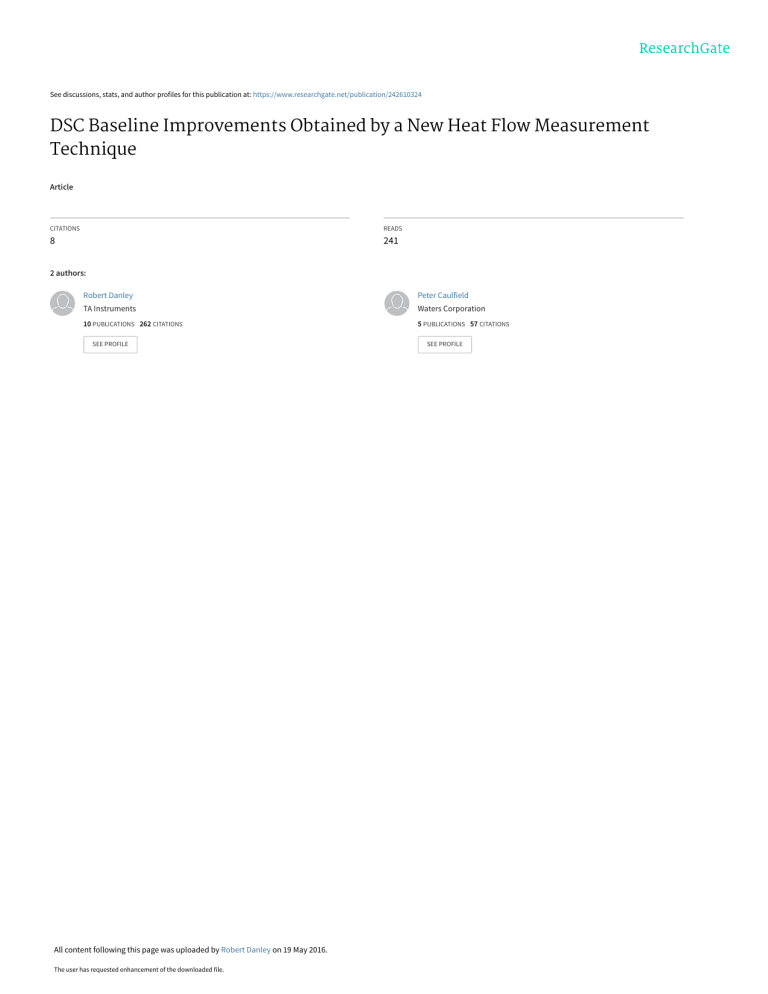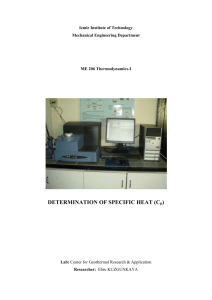
See discussions, stats, and author profiles for this publication at: https://www.researchgate.net/publication/242610324 DSC Baseline Improvements Obtained by a New Heat Flow Measurement Technique Article CITATIONS READS 8 241 2 authors: Robert Danley Peter Caulfield TA Instruments Waters Corporation 10 PUBLICATIONS 262 CITATIONS 5 PUBLICATIONS 57 CITATIONS SEE PROFILE All content following this page was uploaded by Robert Danley on 19 May 2016. The user has requested enhancement of the downloaded file. SEE PROFILE DSC Baseline Improvements Obtained by a New Heat Flow Measurement Technique Robert L. Danley, Peter A. Caulfield TA Instruments, 109 Lukens Drive, New Castle DE 19720 ABSTRACT Nearly all differential scanning calorimetry (DSC) results are affected by the instrument baseline heat flow. Weak transitions, for example glass transitions may not be unambiguously detected if the instrument baseline is not straight. Measurement of heat capacity is influenced by all of the defects in the instrument baseline. A new technique for measuring heat flow in a DSC employing the heat flux principle is described that yields greatly improved instrument baselines. A four-term heat flow measurement equation is used which includes slight instrument imbalances that contribute to baseline defects. A DSC heat flow sensor that uses the four-term heat flow equation is described. The sensor has thermally independent sample and reference positions and two differential temperature measurements. INTRODUCTION Among the more important performance characteristics of a DSC is the instrument baseline, i.e. the residual heat flow signal of the DSC when operated empty. The DSC is a twin instrument, comprising a sample and a reference calorimeter within a common thermal enclosure, where the two calorimeters are assumed to be identical. The output of the DSC is the difference between the heat flows measured by each of the calorimeters. A number of advantages are gained by the use of twin calorimeters including cancellation of heat leakage and temperature disturbances common to both calorimeters (1). It follows that if the two calorimeters are identical and symmetrically positioned within the DSC enclosure, the differential heat flow signal of the empty DSC should be zero. However, all DSCs, whether heat flux or power compensation give nonzero heat flow measurements when operated empty, demonstrating that the instrument is not symmetrical. Heat flux DSCs typically have superior baseline when compared to power compensation DSCs, owing to the much smaller temperature differences between the enclosure and the calorimeters in heat flux DSC. Instrument asymmetry and baseline curvature contribute to errors in heat capacity measurements in DSC (2) and MDSC (3). In virtually all DSCs, the measured signal is the difference between the temperatures of the sample and reference positions of the sensor. Within the instrument the ∆T signal is converted to a heat flow rate using a temperature dependent proportionality factor: q& = E (T )∆T 1 TA268 (1) the proportionality factor E(T) depends upon the geometry and materials of construction of the differential temperature sensor. In commercial instruments, the heat flow proportionality factor is generally determined by the manufacturer and is assumed to be common to all instruments of a given type. To determine the relationship between the measured temperature(s) and heat flow, a mathematical model of the measurement apparatus is used. Analysis of the heat flow measurement is based on the lumped heat capacity method where a thermal system is represented by thermal resistances and heat capacities (4). This type of analysis has frequently been used to model DSC (5-7). Figure 1 shows an equivalent circuit that may be used to represent the heat flow measurement in a DSC. Each calorimeter comprises a thermal resistance and a heat capacity; subscripts s and r indicate the sample or reference calorimeter. Ts and Tr are the measured temperatures of the sample and reference calorimeters and T0 is the temperature of the DSC enclosure. The measured heat flows are qs, the heat flow to the sample and it’s pan and qr, the heat flow to the reference and it’s pan. This model does not include the sample, reference or their pans. qs qr Cs Cr Ts Tr Rs Rr T0 Figure 1 – DSC Heat Flow Measurement Model Performing a heat balance gives the sample and reference heat flows in terms of temperatures Ts, Tr, T0 and sensor thermal parameters Rs, Cs, Rr, Cr: q& s = T0 − Ts dT − Cs s Rs dt (2) q& r = T0 − Tr dT − Cr r Rr dt (3) The difference is taken between the sample and reference heat flows and the two differential temperatures are substituted: ∆T = Ts − Tr ∆T0 = T0 − Ts After rearrangement, the result is a four-term heat flow equation giving the difference between the sample and reference heat flows: 2 TA268 q& = − 1 dT d∆ T ∆T 1 + ∆T0 − √ + (C r − C s ) s − C r √ Rr dt dt Rs Rr ↵ The first term is identical to equation (1), the conventional DSC heat flow. The second and third terms reflect imbalances between thermal resistances and heat capacities of the sample and reference calorimeters. The fourth term is a heat flow associated with differences in heating rate between the sample and reference calorimeters, it is generally zero except when a transition is occurring in the sample, or during MDSC experiments (8). A principle difference between this heat flow equation and those previously used in DSC is that the calorimeters have not been assumed to be identical. To use this equation, the sensor heat capacities and thermal resistances must be known, the DSC must include the two differential temperature measurements and the sample and reference calorimeters must be independent. A new heat flux DSC and sensor have been designed to meet these measurement requirements (9) and a calibration procedure allows the sensor thermal parameters to be determined. Calibration involves the determination of the values for Rs, Rr, Cs and Cr. The calibration procedure includes two identical constant heating rate experiments; the first is performed with the DSC empty and the second with sapphire disks without pans on the sample and reference positions. For the empty DSC experiment, the sample and reference heat flow are set equal to zero, the heat balance equations (2) and (3) are solved, thus giving the calorimeter time constants: τ s = C s Rs = ∆T0 dTs dt τ r = C r Rr = ∆T0 − ∆T dTs d∆T − dt dt The time constants are a function of temperature. For the sapphire disk experiment, the sample and reference heat flows from equations (2) and (3) are set equal to the heat flow to the sapphire disks, which equals the product of sapphire mass, heat capacity and heating rate. The sample and reference sapphire disk heating rates are assumed to be equal to the heating rates of the sample and reference calorimeters. This is a reasonable assumption, as sapphire has no first order transitions in this temperature region. These equations are solved to give the calorimeter heat capacities: Cs = ms csapph ∆T0 −1 dTs τs dt Cr = mr c sapph ∆T0 + ∆T −1 dTs d∆T − √τ r dt ↵ dt Where, the calorimeter time constants were determined by the first experiment. Thermal resistances are found using the time constants and heat capacities: 3 TA268 Rs = τs Cs Rr = τr Cr Thus, thermal parameters of the calorimeters as a function of temperature are determined. The twin calorimeter sensor assembly is shown in Figure 2, it includes provisions for measuring temperatures Ts , T0 and differential temperatures ∆T and ∆T0. It was designed such that the sample and reference calorimeters are thermally independent, in other words, heat flow in one calorimeter does not affect the temperature of the other. The main body of the sensor is constantan and consists of a thick flat base and a pair of thin wall closed end cylinders integral with the base. The thin wall section creates the thermal resistance and the flat end surfaces hold the sample and reference. A thin chromel disk is welded to the Figure 2 - Tzero DSC Sensor Assembly underside of each platform and functions as an area thermocouple junction to reduce sensitivity to variations of contact between sensor and pans (10). A chromel wire is welded to each chromel disk. A constantan and a chromel wire are welded to the center of the base structure. The base surface is brazed to the silver DSC enclosure, which makes the base of the sensor assembly isothermal. Differential temperature ∆T is measured between the chromel wires attached to the chromel disks and ∆T0 is measured between the chromel wires attached to the sample chromel disk and the sensor base. Ts is measured between the sample chromel wire and the base constantan wire. T0 is measured between the constantan and chromel wires attached to the sensor base. T0 is used to control the temperature of the DSC. EXPERIMENTAL Instrument baseline scans were performed using a TA Instruments Q1000 DSC that incorporates the heat flow sensor assembly and heat flow measurement method 4 TA268 described above. Baselines were run at 20°C/min. using the refrigerated cooling system (RCS). Calibration of the sensor parameters was performed using the RCS at a heating rate of 20°C/min. The DSC cell and RCS were purged with nitrogen. RESULTS AND DISCUSSION A comparison of the empty DSC baseline of a Q1000 with RCS and a 2920 DSC with RCS is shown in Figure 3, this comparison is particularly apt, because the 2920 is notable for excellent baseline performance. The Q1000 baseline is superior in every way, the start-up offset is much smaller, the baseline is dramatically straighter and slope is greatly reduced. As expected of a twin calorimeter, the empty instrument heat flow signal is very nearly zero everywhere during the experiment. Notice that the heat flow scale is 1.0 mW and that the Q1000 data extends from –80°C to 400°C. Heat Flow (mW) 0.50 Heat Flow Q1000 Heat Flow 2920 0.25 0.00 -0.25 -0.50 -100 25 150 275 Temperature (°C) 400 Figure 3 - Instrument Baseline Comparison Figure 4 shows a plot of instrument baselines produced by the Q1000 DSC using the RCS. Eight consecutive scans were made between –90°C and 400°C to demonstrate baseline performance. The total range of heat flow variation is less than 0.040 mW. All baselines are very straight, have very little slope and very small start-up offsets. Between any two consecutive baselines the variation is no greater than 0.020 mW. These results show that excellent baseline performance may be obtained over a very broad range of temperatures with excellent repeatability. Among the benefits of the baseline improvements achieved by the Tzero DSC are the ability to measure very weak transitions (11). 5 TA268 Heat Flow (mW) 0.2 0.1 0.0 -0.1 -0.2 -100 0 100 200 Temperature (°C) 300 400 Figure 4 - Q1000 Instrument Baselines Using RCS CONCLUSIONS Beginning from first principles, a new DSC heat flow measurement technique has been developed. Unlike traditional DSC, the instrument has not been assumed to be perfectly symmetric and the measurement includes the effects of sensor asymmetry. A new DSC sensor has been developed that includes two differential temperature measurements so that the measurement model can be used. A calibration technique has been developed that gives a more thorough characterization of the DSC sensor and includes the effects of asymmetry. One of the important benefits of the Tzero DSC technology is a dramatic improvement in instrument baseline performance. REFERENCES 1. W. Hemminger and G. Höhne, Calorimetry Fundamentals and Practice, 1984, 77-79. 2. V. B. F. Mathot, in: Calorimetry and Thermal Analysis of Polymers, V.B.F. Mathot (Ed.), 1994, 108-109. 3. A. Boller, et.al. , J. Thermal Analysis, 1997, v49 1081-1088 4. J. P. Holman, Heat Transfer, 4th Edition, 1976, 97-102. 5. A. P. Gray, in: Analytical Calorimetry, R. S. Porter, J. F. Johnson (Eds.), 1968, v1 209-218. 6. R. A. Baxter, in: Thermal Analysis, R. F. Schwenker, P. D. Garn (Eds.), 1969 v1 65-84. 7. G. W. H. Höhne, W. Hemminger H.-J. Flammersheim, Differential Scanning Calorimetry, 1996, 21-33 8. R. L. Danley, P. A. Caulfield, Proc. 29th N. Amer. Therm. Anal. Soc., 2001 9. L. Waguespack, R. L. Blaine, Proc. 29th N. Amer. Therm. Anal. Soc., 2001 10. U.S. Patent 4,095,453, Differential Thermal Analysis Cell, 1978 11. P. A. Caulfield, L.C. Thomas, Proc. 29th N. Amer. Therm. Anal. Soc., 2001 6 TA268 7 View publication stats TA268


